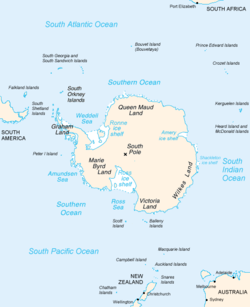Totten Glacier
| Totten Glacier | |
|---|---|
 Map of Antarctica, with Wilkes Land slightly to the right | |
Location of Totten Glacier in Antarctica | |
| Location | Wilkes Land |
| Coordinates | 67°00′00″S 116°20′00″E / 67.00000°S 116.33333°E |
Totten Glacier is a large glacier draining a major portion of the East Antarctic Ice Sheet, through the Budd Coast of Wilkes Land in the Australian Antarctic Territory. The catchment drained by the glacier is estimated at 538,000 km2 (208,000 sq mi),[1] extending approximately 1,100 km (680 mi) into the interior and holds the potential to raise sea level by at least 3.5 m (11 ft).[2] Totten drains northeastward from the continental ice but turns northwestward at the coast where it terminates in a prominent tongue close east of Cape Waldron. It was first delineated from aerial photographs taken by USN Operation Highjump (1946–47), and named by Advisory Committee on Antarctic Names (US-ACAN) for George M. Totten, midshipman on USS Vincennes of the United States Exploring Expedition (1838–42), who assisted Lieutenant Charles Wilkes with correction of the survey data obtained by the expedition.
Totten Ice Shelf is a 6,200 km2 (2,400 sq mi) floating portion of Totten Glacier, laterally bounded by the
Totten Glacier Tongue (66°35′S 116°5′E / 66.583°S 116.083°E) is a small
Melt
Totten Glacier drains the
Surface altimetry measurements from
Totten Glacier loses mass primarily through melt at its ice shelf base,[12][13] and melt is influenced by the availability of ocean heat entering the cavity below the ice shelf.[5][15][17][18] Warm, modified Circumpolar deep water enters the Totten Ice Shelf cavity through submarine canyons,[2][19] driven by wind processes at the nearby continental shelf break.[5] Wind processes and sea ice formation along the Sabrina Coast have been linked to variability in Totten Ice Shelf basal melt[17][18] and calving rates.[6][20]
A study in 2019 (published 2023) at the outfall of the Totten Glacier in East Antarctica showed that water at depth, above freezing temperature, was melting the under-side of the glacier.[21][22]
See also
- Cape Mikhaylov
- Ice stream
- List of glaciers in the Antarctic
- List of Antarctic ice streams
- Retreat of glaciers since 1850
References
- hdl:2152/41173.
- ^ ISSN 1752-0908.
- S2CID 4348022.
- PMID 29928691.
- ^ PMID 29109976.
- ^ ISSN 1994-0416.
- S2CID 4425075.
- doi:10.1038/ngeo102.
- ^ "Gravimetric Mass Balance". February 7, 2018.
- S2CID 4334500.
- S2CID 205228290.
- ^ S2CID 206548095.
- ^ S2CID 4462940.
- S2CID 206632749.
- ^ ISSN 1944-8007.
- S2CID 55567382.
- ^ PMID 24305466.
- ^ ISSN 1812-0792.
- PMID 28028540.
- PMID 27386519.
- ^ Helicopter-Based Ocean Observations Capture Broad Ocean Heat Intrusions Toward the Totten Ice Shelf, Yoshihiro Nakayama et al, AGU, 2023-09-11
- ABC News Online, 2023-09-13
![]() This article incorporates public domain material from "Totten Glacier". Geographic Names Information System. United States Geological Survey.
This article incorporates public domain material from "Totten Glacier". Geographic Names Information System. United States Geological Survey.

